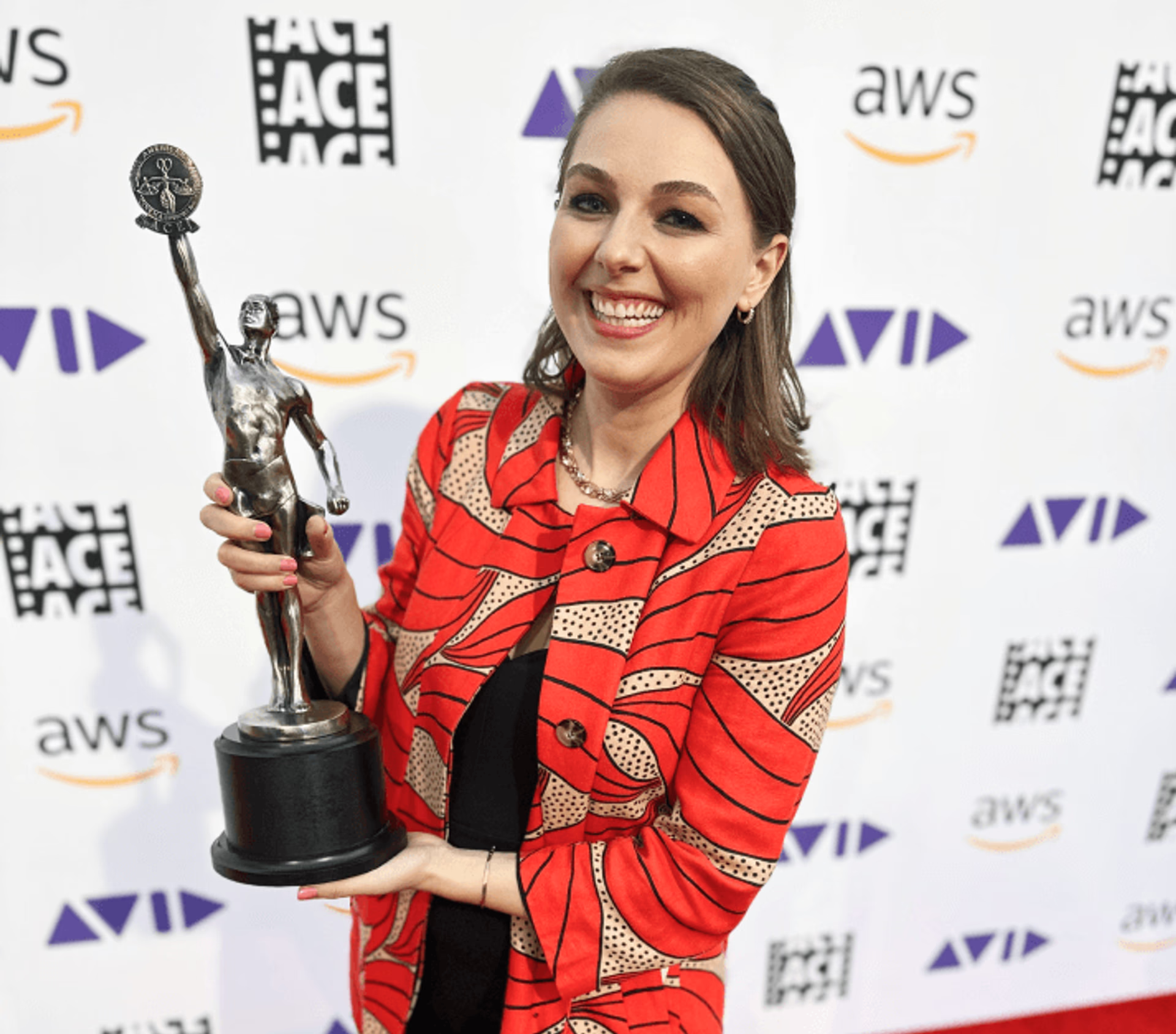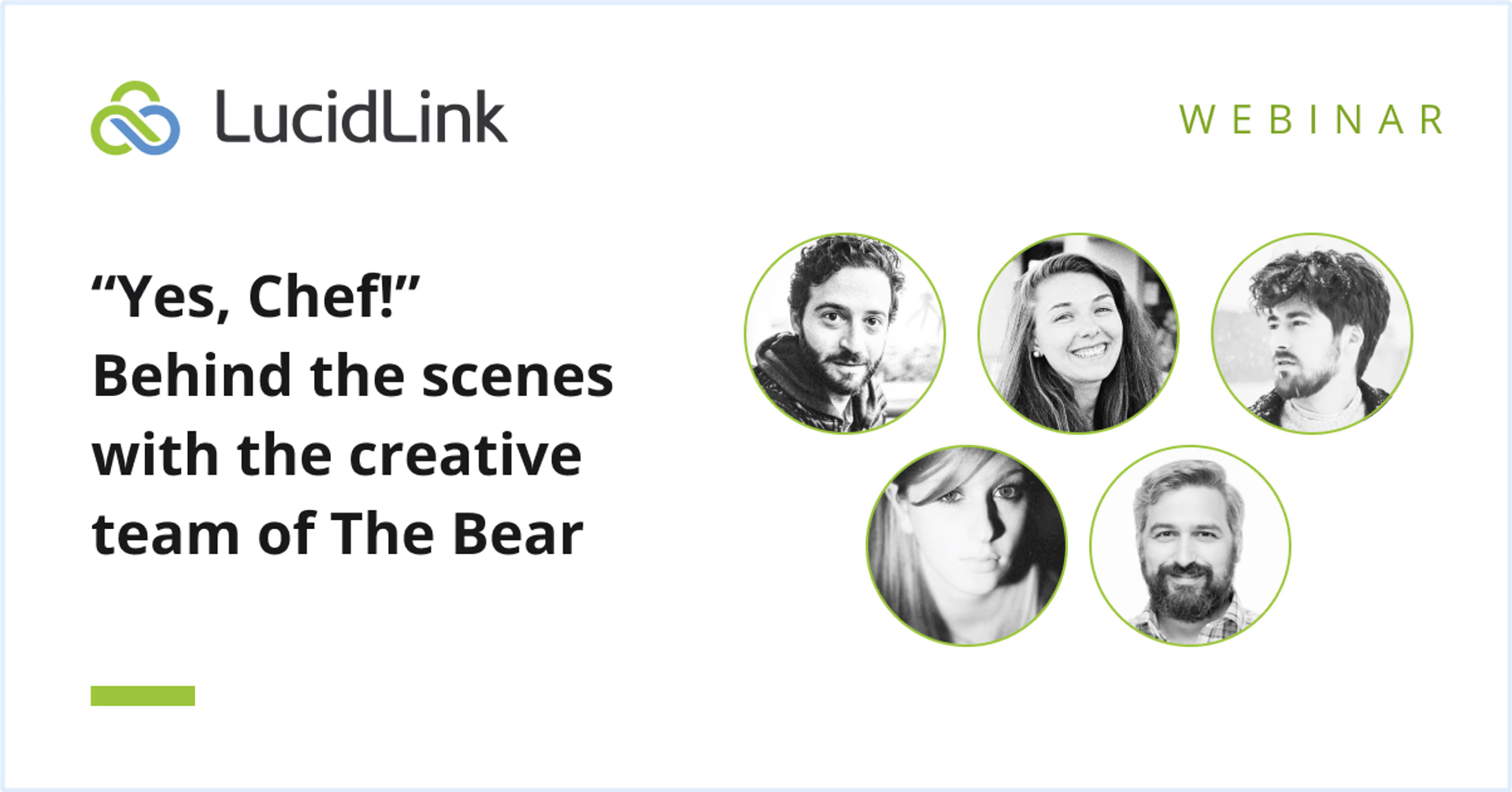The creative secrets behind the critically-acclaimed series, The Bear
April 2024
9 mins

Table of contents
Just add LucidLink
No barriers to entry. Nothing new to learn. Known and familiar user interfaces that you choose for your team.
Start your free trialThe kitchen is where the drama really cooks up in the binge-worthy TV series “The Bear.” The critically acclaimed comedy-drama hit television screens in the summer of 2022, captivating audiences with its gripping plot, meticulous editing, and compelling performances. The Bear holds a perfect 100-percent Rotten Tomatoes rating and continues to receive recognition from prestigious awards such as the Golden Globes, Critics’ Choice Awards, AFI, and SAG Awards.

Instrumental to its success is a passionate team of editors who pushed the boundaries of remote collaboration and proved that distance is no obstacle to creating an exceptional work of art. In season 1, the editors, Joanna Naugle and Adam Epstein, along with assistant editors Megan Mancini and Josh DePew, formed a stellar team working predominantly in a remote capacity. For season 2, the team embraced a hybrid workflow, adding support from Noah Benezra, Oliver Benezra, and Travis Cummings, who joined The Bear’s post-production team as new assistant editors.

Joanna Naugle and Adam Epstein at the Eddie Awards 2023
As the much-anticipated second season of the hit series premieres today, we had the opportunity to chat with award-winning editor Joanna Naugle to learn about the fascinating work that went on behind the scenes. We’ll take a closer look at the unique concept of the show and explore the creative strategies and tools that helped the editorial team break the barriers of remote work to create the sensational hit The Bear.
Don’t worry, no spoilers ahead! We highly recommend watching the series.
Immersing in a fast-paced restaurant kitchen
The cramped, chaotic kitchen of a Chicago sandwich shop is the primary set of The Bear. Part of what makes the show so good is being immediately immersed in its fast-paced nature. The show’s intense montages add depth to the realistic depiction of a high-pressure restaurant kitchen, with its stress, yelling, cutting, and burns.
“All shots are designed to make you feel like you are actually in the kitchen alongside the characters. I intentionally favored footage that had some sort of foreground element, like someone’s shoulder, steam rising from a pot, or the edge of a pan in the shot, along with the character. This made everything feel more claustrophobic and condensed and added to the overall feeling of stress. In chaotic moments, I chose to keep accidental camera bumps or extra movements because they added to the authenticity and immersive nature of the scenes,” admits Joanna.

A stand-out moment in season 1 is the masterfully done “oner” episode. A fan-favorite, episode 7, titled “Review,“ was shot in one long uninterrupted 17-minute take—a special treat that added another layer to the show’s sense of urgency and relevance to the everyday pressures of working in a kitchen. While it’s easy to think a one-shot sequence leaves little to do for editors, this can’t be further from the truth.
“I got to do tons of temp sound design that would bring the episode to life,” says Joanna.
And sound design plays a vital role in the show. “Luckily, Christopher Storer and Josh Senior, the show’s creator and executive producer, curate the music. It’s an aspect that people commented on in season 1 and will see again in season two”, mentions Joanna. The soundtrack drives the tempo, pace, and excitement of the show. “They sent me an amazing playlist when I started working on the pilot, which had everything from movie scores to rap to jazz to heavy metal. I loved being able to cut such a music-driven show, and having this playlist as a starting point was great.”

In preparation for The Bear, Christopher Storer also recommended Joanna watch the film “Bringing out the dead” by Martin Scorsese. The movie is about an NYC paramedic in the 90s and how his anxiety and emotional baggage blur the line between reality and nightmares. “The editing (by the incomparable Thelma Schoonmaker) is absolutely incredible, and I studied many of the scenes in the film as we were figuring out how to achieve a similar effect of mixing calm with chaos throughout the series,” shares Joanna.
The post-production workflow
Just like in a good restaurant, it’s hard to imagine all the intense preparations, work, and problem-solving happening in the post-production “kitchen” of a show like The Bear. Some of the unique challenges for the editorial team were finding and maintaining the right pace, managing overlapping dialogue, and handling immense volumes of B-roll footage.
Pacing
A creative decision the team had to take early in the process was finding the right balance of information to feed to the audience. “Nailing down the pace in the first episode was difficult, but ultimately really creatively fulfilling,” explains Joanna. “Christopher Storer (the creator of the show and director of the pilot) wanted the audience to feel immediately immersed in Carmy’s inherited stress in taking over [his brother’s restaurant] ‘The Beef’. We had to find the balance between making the first episode feel intense while still giving the viewers all the information they needed to not feel completely lost,” reveals Joanna.
The team spent a lot of time shuffling scenes, combining certain moments into montages, and even removing footage that they loved but ultimately didn’t fit within the episode. Joanna mentions her biggest lesson learned: “Realizing we didn’t need to spoon-feed information to audiences to get them on board with the story.”
Overlapping dialogue
The assistant editors faced the challenge of handling multiple voices talking simultaneously when receiving dailies. To resolve this, they organized the footage by creating a line-by-line string out, grouping every instance of someone saying a specific line together. Followed by meticulously arranging them in a timeline with different layers or color labels.
The naturally-flowing dialogue is one of the distinct features of The Bear. The actors demonstrated impeccable timing and authentically performed overlapping lines during intense scenes and the editors eliminated any remaining pauses or breaths to further enhance the energy and excitement.
Staying organized
Joanna shares that to manage everything behind-the-scenes, meet tight deadlines, and handle extensive B-roll footage, the team needed to be very organized. “Being organized is crucial for me to make effective creative decisions. Our assistant editors do an excellent job of ensuring clearly labeled files and a clear project structure.” Having a polished and easily navigable workflow setup enables Joanna to see the big picture and select the best material to piece together.
Despite limited in-person editing presence due to COVID restrictions, constant dialogue with the production team facilitated adjustments and collaboration. The editor’s cut, available a few days after wrapping production, served as a starting point for further refinement.
As creatives strive to navigate post-production challenges and turn them into triumphs, the indispensable role of the right tech tools becomes apparent. It’s no wonder that production teams like Joanna’s are embracing the shift to cloud-based solutions to effortlessly store and manage media assets, unlocking new possibilities for streamlined workflows and creative collaboration.
The creative toolkit
When selecting the right tools for the job, the editorial team behind The Bear had to take into account the unique nature of the TV series, as well as the COVID restrictions present during season 1. With Season 2, the team, all based in the NYC Tri-state area, welcomed more in-person collaboration out of the facility Senior Post. Still, the ability to collaborate in a remote set-up has allowed for more focused work and a balance between personal and professional commitments.
“It’s been a positive change to have the flexibility of working from home on certain days with the right tools while also being able to go to the office and seamlessly continue where we left off,” Joanna acknowledges candidly.

The team used Premiere Pro Productions to keep everything organized and coordinated. “We had an immense amount of B-roll to use in both seasons that was shared across all the episodes. Having a shared project within Adobe Productions that Adam and I could access and pull from was essential as we built out the world of The Beef [the restaurant and primary setting of the series],” states Joanna. In addition, the post team employed After Effects for any quick screen comps, DaVinci Resolve for coloring, and Frame.io for review and collaboration.
To stay connected online, Joanna and her colleagues used Zoom and Slack. “We were on Slack all the time, hopping on Zoom and screen sharing. And then coming into the office as needed. It’s helpful to get in the room with someone or hop on Zoom and be like, “I think I got this 80% of the way there, how do we get the last like 20?” So it’s nice to kind of have my isolation when I need to, but then also have the collaboration.”
The shared space for the show’s entire library was LucidLink, with dailies sometimes being stored on local drives and the rest of the media, like project files, visual effects, and sound effects, on LucidLink.
Using LucidLink for our shared storage eliminated that headache and allowed us to focus on the creative aspects of editing rather than the tedious parts of media management.
“LucidLink was hugely helpful on The Bear. In the early days of the pandemic, it always felt like you had to allot hours of your day to mirroring drives, syncing up with collaborators, and making sure that media was relinking between all the editors and AEs on a project. Using LucidLink for our shared storage eliminated that headache and allowed us to focus on the creative aspects of editing rather than the tedious parts of media management,” says Joanna.
To meet the tight deadline of completing the entire season 1 in 4 months, it was essential to have tools that work seamlessly together. In this context, the combination of Premiere Pro and LucidLink proved invaluable. It allowed the team to work as if they were on the same server, creating a shared nexus where they could easily access all necessary resources.
Tips for creatives
Additionally, Joanna shares her knowledge into actionable tips and tricks for improving your editing process and staying productive. Such as using label colors to organize a project. “I typically use different labels for each scene in an episode so I can easily jump between them and see when one section starts and another stops.”
As an editor, Joanna stresses the importance of trusting your instincts: “Sometimes, if you spend too much time with an edit, you start second-guessing things, like whether a joke is still funny. However, if we laughed at it a hundred times before, chances are it’s still humorous. The point I’m trying to make is that over-editing can lead to unnecessary changes just for the sake of change. It’s important to have confidence in your work and know when it’s done, even if it means stepping away.”
As for staying motivated and productive? “Don’t procrastinate and overthink the final product. Just start putting things together and see what works. It’s okay if your first cut isn’t perfect. TV shows come together gradually, so focus on keeping things moving forward. Take breaks when you’re stuck and come back with a fresh perspective,” Joanna advises.
And if you’re just starting out in post-production, master the necessary programs and learn how to be highly organized to keep things running smoothly. “The best AEs I’ve worked with are always thinking three steps ahead of me, brainstorming what they can be doing to avert problems down the line or getting ahead on work that needs to be done in the future. If you’re waiting around for someone to tell you what to do, you’re not making anyone’s life easier and won’t gain the trust of the people you’re working with.”
Want to know more tips and tricks for video editing? Watch our webinar to learn more from the team behind the award-winning FX series The Bear.

The dedication and creativity of the remote editing team, along with their effective use of tech tools, have played a crucial role in bringing this unique and energetic series to life.
There are many great dishes that are made from the same basic ingredients – it’s what you do with them that counts, and The Bear gets the balance between atmosphere and story, sour and sweet, just right.
Image source: The Bear, FX
Keep reading

How The Finish Line reclaims time to make work-life balance a reality
Discover how The Finish Line uses cloud workflows to support remote post-production, creative collaboration and make every second count.
10 April 2025, 6 mins read

Breaking new ground with virtual production and remote collaboration
Discover how virtual production and remote collaboration tools like Magicbox and LucidLink unlock a new era of creative freedom.
02 September 2024, 4 mins read

Remote collaboration fuels Oscar-winning success for the team behind 'The Boy, The Mole, The Fox and The Horse'
Brought to life during the COVID-19 pandemic, the film included the exceptional remote teamwork of more than 120 people from over 20 countries in production over 16 months.
11 April 2024, 6 mins read
Join our newsletter
Get all our latest news and creative tips
Want the details? Read our Privacy Policy. Not loving our emails?
Unsubscribe anytime or drop us a note at support@lucidlink.com.